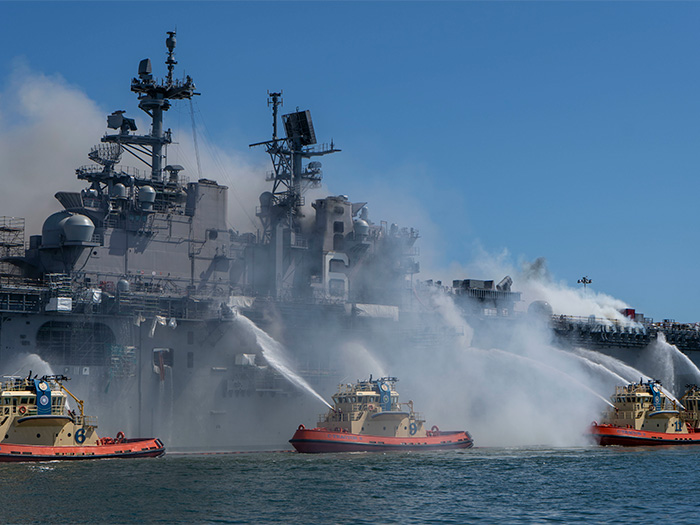
GAO: Navy needs to up ship fire prevention efforts
Written by Nick Blenkey
Despite days long efforts to fight the Bonhomme Richard fire, damage was so extensive that it was decided to decommission the ship [U.S. Navy photograph]
According to the Navy, more than $4 billion in estimated total damage resulted from 15 major fire incidents that occurred onboard ships undergoing maintenance from May 2008 through July 2020. Two ships were lost during this period, including the USS Bonhomme Richard [a loss which a subsequent Navy report found to have been “completely preventable”]. Additionally, multiple personnel suffered from injuries in the ship fires, although no deaths were reported from these incidents.
In response to Congressional requests, the U.S. Government General Accounting Office (GAO) has reviewed issues related to fires on Navy ships during maintenance.
In its report on what it found, the GAO notes that U.S. Navy ships undergoing maintenance face a high risk of fire, in part because repairs can involve sparks or welding in confined areas with flammable material.
Navy organizations collect and analyze lessons learned from fires through a number of processes. However, says GAO, the Navy does not have a process for consistently collecting, analyzing, and sharing the lessons learned. As a result, the Navy has lost lessons learned over time—such as steps that a ship can take to improve fire safety. Organizations that GAO interviewed collected lessons learned from fires; however, they had not consistently used the approved Navy-wide system to store and share them. Establishing a process for the consistent collection, analysis, and sharing of fire-related lessons learned would assist the Navy in improving behavior and reduce the risk of ships repeating costly mistakes.
Although the Navy has begun improving the collection of data related to fires aboard ships during maintenance in the Navy’s safety database, no organization is analyzing the broad effects of fires on the Navy’s operations and strategic resources. Without conducting such analyses, says the GAO, the Navy will not have a complete picture of the magnitude of risks associated with ship fires. In addition, senior leaders and policymakers can use these analyses to inform their prioritization of resources for fire prevention and mitigation relative to other competing interests.
Navy organizations responsible for training have assessed the effectiveness of their individual training efforts in multiple ways—such as conducting course evaluations and fire drills. However, the Navy has not assessed the effectiveness of its collective training efforts service-wide. The Navy has not set service-wide goals, performance measures, and a process to monitor progress for its collective training efforts to improve fire safety and response. By establishing these practices service-wide, Navy leadership would have the information needed to determine the extent to which its training efforts are effective in reducing the incidence and severity of ship fires.
RECOMMENDATIONS
GAO is making three recommendations to the Navy:
- The Secretary of the Navy, in collaboration with the Office of the Chief of Naval Operations, should ensure that the Navy issues guidance to require a process that will allow consistent collection, analysis, and sharing of fire safety-related lessons learned.
- The Secretary of the Navy, in collaboration with the Office of the Chief of Naval Operations, should ensure that a single organization is responsible for using existing fire-incident data to analyze the broad effects that fire incidents for ships undergoing maintenance have on Navy operations and inform the Navy’s response to risks.
- The Secretary of the Navy, in collaboration with the Office of the Chief of Naval Operations, should ensure establishment of (1) service-wide goals and performance measures for the Navy’s fire-safety training activities and, (2) a process to monitor and report progress toward these goals.
Download the full GAO report HERE




